Nagasaki, Nagasaki
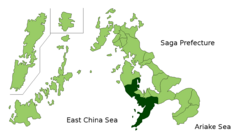 Nagasaki's location in Nagasaki Prefecture, Japan. |
|
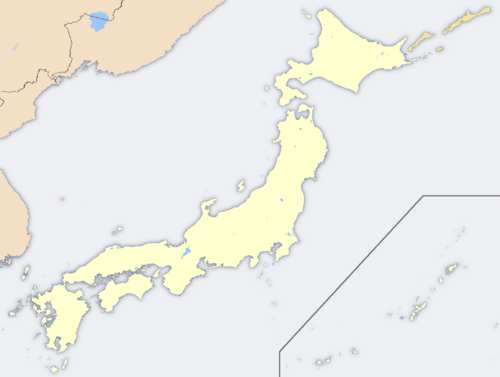 Nagasaki's location in Japan. |
|
| Location | |
| Country | Japan |
| Region | Kyūshū |
| Prefecture | Nagasaki Prefecture |
| District | N/A |
| Physical characteristics | |
| Area | 406.35 km2 (156.89 sq mi) |
| Population (as of 2007) | |
| Total | 459,198 |
| Density | 1,120.1 /km² (2,901 /sq mi) |
| Location | |
| Symbols | |
| Tree | Chinese tallow tree |
| Flower | Hydrangea |
| Nagasaki Government Office | |
| Mayor | Tomihisa Taue (2007-) |
| Address | 2-22 Sakura-machi, Nagasaki-shi, Nagasaki-ken 850-8685 |
| Phone number | 095-825-5151 |
| Official website: City of Nagasaki | |
Nagasaki (長崎市 Nagasaki-shi?) (listen) is the capital and the largest city of Nagasaki Prefecture in Japan. It was formerly part of Nishisonogi District. It was a center of European influence in the sixteenth century. Nagasaki became a major Imperial Japanese Navy base during the First Sino-Japanese War and Russo-Japanese War.
During World War II, the atomic bombings of Hiroshima and Nagasaki made Nagasaki the second city in the world to be subject to nuclear warfare.[1]
Contents |
Geography
Nagasaki and Nishisonogi Peninsulas are located within the city limits. The city is surrounded by the cities of Isahaya and Saikai, and the towns of Togitsu and Nagayo in Nishisonogi District.
Nagasaki lies at the head of a long bay which forms the best natural harbor on the island of Kyūshū. The main commercial and residential area of the city lies on a small plain near the end of the bay. Two rivers divided by a mountain spur form the two main valleys in which the city lies. The heavily built-up area of the city is confined by the terrain to less than 4 square miles.
History
Medieval era

Founded before 1500, Nagasaki was originally secluded by harbors. It enjoyed little historical significance until contact with European explorers in 1542, when a Portuguese ship landed nearby, somewhere in Kagoshima prefecture. The Navarrese Jesuit missionary St. Francis Xavier arrived in another part of the territory in 1549, but left for China in 1551 and died soon afterwards. His followers who remained behind converted a number of daimyo (feudal lords). The most notable among them was Omura Sumitada, who derived great profit from his conversion through an accompanying deal to receive a portion of the trade from Portuguese ships at a port they established in Nagasaki in 1571 with his assistance.
The little harbor village quickly grew into a diverse port city, and Portuguese products imported through Nagasaki (such as tobacco, bread, textiles and a Portuguese sponge-cake called castellas) were assimilated into popular Japanese culture. Tempura, while not Portuguese in origin, takes its name from the Portuguese word, 'Tempero,' another example of the enduring effects of this cultural exchange. The Portuguese also brought with them many goods from China.
Due to the instability during the Warring States period, Sumitada and Jesuit leader Alexandro Valignano conceived a plan to pass administrative control over to the Society of Jesus rather than see the Catholic city taken over by a non-Catholic daimyo. Thus, for a brief period after 1580, the city of Nagasaki was a Jesuit colony, under their administrative and military control. It became a refuge for Christians escaping maltreatment in other regions of Japan.[2] In 1587, however, Toyotomi Hideyoshi's campaign to unify the country arrived in Kyūshū. Concerned with the large Christian influence in southern Japan, as well as the active and what was perceived as the arrogant role the Jesuits were playing in the Japanese political arena, Hideyoshi ordered the expulsion of all missionaries, and placed the city under his direct control. However, the expulsion order went largely unenforced, and the fact remained that most of Nagasaki's population remained openly practicing Catholics.
In 1596, the Spanish ship San Felipe was wrecked off the coast of Shikoku, and Hideyoshi learned from its pilot (so says the Jesuit account) that the Spanish Franciscans were the vanguard of an Iberian invasion of Japan. In response, Hideyoshi ordered the crucifixions of twenty-six Catholics in Nagasaki on February 5 of that year (the Twenty-six Martyrs of Japan). Portuguese traders were not ostracized, however, and so the city continued to thrive.

In 1602, Augustinian missionaries also arrived in Japan, and when Tokugawa Ieyasu took power in 1603, Catholicism was still grudgingly tolerated. Many Catholic daimyo had been critical allies at the Battle of Sekigahara, and the Tokugawa position was not strong enough to move against them. Once Osaka Castle had been taken and Toyotomi Hideyoshi's offspring killed, though, the Tokugawa dominance was assured. In addition, the Dutch and English presence allowed trade without religious strings attached. Thus, the hammer fell in 1614, with Catholicism officially banned and all missionaries ordered to leave. Most Catholic daimyo apostatized, and forced their subjects to do so, although a few would not renounce the religion and left the country as well. A brutal campaign of persecution followed, with thousands across Kyūshū and other parts of Japan killed, tortured, or forced to renounce their religion.
Catholicism's last gasp as an open religion, and the last major military action in Japan until the Meiji Restoration, was the Shimabara rebellion of 1637. While there is no evidence that Europeans directly incited the rebellion, Shimabara had been a Christian han for several decades, and the rebels adopted many Portuguese motifs and Christian icons. Consequently, in Tokugawa society the word "Shimabara" solidified the connection between Christianity and disloyalty, constantly used again and again in Tokugawa propaganda.
The Shimabara rebellion also convinced many policy-makers that foreign influences were more trouble than they were worth. The Portuguese, who had been previously living on a specially-constructed island-prison in Nagasaki harbor called Dejima, were expelled from the archipelago altogether, and the Dutch were moved from their base at Hirado into the trading island. In 1720 the ban on Dutch books was lifted, causing hundreds of scholars to flood into Nagasaki to study European science and art. Consequently, Nagasaki became a major center of rangaku, or "Dutch Learning". During the Edo period, the Tokugawa shogunate governed the city, appointing a hatamoto, the Nagasaki bugyō, as its chief administrator.
Consensus among historians was once that Nagasaki was Japan's only window on the world during its time as a closed country in the Tokugawa era. However, nowadays it is generally accepted that this was not the case, since Japan interacted and traded with the Ryukyus, Korea and Russia through Satsuma, Tsushima and the north of Honshū respectively. Nevertheless, Nagasaki was depicted in contemporary art and literature as a cosmopolitan port brimming with exotic curiosities from the Western World.[3]
In 1808, the Royal Navy frigate HMS Phaeton entered Nagasaki Harbor in search of Dutch trading ships. The local magistrate was unable to resist the British demand for food, fuel, and water, later committing seppuku as a result. Laws were passed in the wake of this incident strengthening coastal defenses, threatening death to intruding foreigners, and prompting the training of English and Russian translators.
The Tōjinyashiki or Chinese Factory in Nagasaki was also an important conduit for Chinese goods and information for the Japanese market. Various colorful Chinese merchants and artists sailed between the Chinese mainland and Nagasaki. Some actually combined the roles of merchant and artist such as 18th century Yi Hai.
Modern era



U.S. Commodore Matthew Perry landed in 1853. The Shogunate crumbled shortly afterward, and Japan opened its doors once again to foreign trade and diplomatic relations. Nagasaki became a free port in 1859 and modernization began in earnest in 1868.
With the Meiji Restoration, Nagasaki quickly began to assume some economic dominance. Its main industry was ship-building. This very industry would eventually make it a target in World War II, since many warships used by the Japanese Navy during the war were built in its factories and docks.
World War II and atomic bombing
On August 9, 1945, Nagasaki was the target of the world's second atomic bomb attack at 11:02 a.m., when the north of the city was destroyed and an estimated 40,000 people were killed. According to statistics found within Nagasaki Peace Park, the death toll from the atomic bombing totalled 73,884, as well as another 74,909 injured, and another several hundred thousand diseased and dying due to fallout and other illness caused by radiation.[4]
Much has been written in news reports, novels, and popular culture about Nagasaki in the years after the bombing. See for instance First Into Nagasaki.
Reconstruction after the war
The city was rebuilt after the war, albeit dramatically changed. New temples were built, as well as new churches due to an increase in the presence of Christianity. Nagasaki is the seat of a Roman Catholic Archdiocese led by Archbishop Joseph Mitsuaki Takami.[5] Some of the rubble was left as a memorial, such as a one-legged torii gate and an arch near ground zero. New structures were also raised as memorials, such as the Atomic Bomb Museum. Nagasaki remains first and foremost a port city, supporting a rich shipping industry and setting a strong example of perseverance and peace.
Nagasaki in Western music and song
Nagasaki is the title and subject of a 1928 song with music by Harry Warren and lyrics by Mort Dixon. See Nagasaki (song). Nagasaki is also the setting for Puccini's opera Madama Butterfly. "Nagasaki Nightmare" is a song about the bomb by anarchist punk group Crass. Swedish crust punk group Totalitär has written a song entitled "Hiroshima, Nagasaki, Stockholm".
Schools
Universities
|
|
Junior Colleges
|
|
Transportation
The nearest airport is Nagasaki Airport in the neighboring city of Ōmura. The Kyushu Railway Company provides rail transportation on the Nagasaki Main Line, whose terminal is at Nagasaki Station. In addition, the Nagasaki Electric Tramway operates five routes in the city. The Nagasaki Expressway serves vehicular traffic with interchanges at Nagasaki and Susukizuka. In addition, six national highways crisscross the city: Routes 34, 202, 251, 324, and 499.
Tourism
Sights
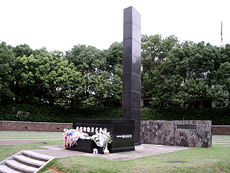


- Confucius Shrine (孔子廟?)
- Dejima Museum of History
- Former residence of Shuhan Takashima (高島秋帆旧宅?)
- Former site of Latin Seminario (旧羅典神学校?)
- Former site of the British Consulate in Nagasaki (旧長崎英国領事館?)
- Former site of Hong Kong and Shanghai Banking Corporation Nagasaki Branch (旧香港上海銀行長崎支店?)
- Glover Garden (グラバー園?)
- Gunkanjima (軍艦島?)
- Former Glover Residence
- Former Alt Residence
- Former Ringer Residence
- Former Walker Residence
- Higashi-Yamate Juniban Mansion (東山手十二番館?)
- Kōfuku-ji (興福寺?)
- Megane Bridge (眼鏡橋?)
- Mount Inasa (稲佐山?)
- Nagasaki Atomic Bomb Museum [2] (Located next to the Peace Park)
- Nagasaki Museum of History and Culture ([3] 長崎歴史文化博物館?)
- Nagasaki National Peace Memorial Hall for the Atomic Bomb Victims
- Nagasaki Peace Park (平和公園?)
- Atomic Bomb Hypocenter (Located near the Peace Park)
- Nagasaki Penguin Aquarium ([4] 長崎ペンギン水族館?)
- Nagasaki Chinatown ([5] 長崎新地中華街?)
- Nagasaki Science Museum ([6] 長崎市科学館?)
- Nagasaki Subtropical Botanical Garden
- Nyoko-do Hermitage
- Ōura Church (大浦天主堂?)
- Sanno Shrine - One-Legged Arch (山王神社?)
- Shusaku Endo Literary Museum
- Siebold Memorial Museum
- Sōfuku-ji (崇福寺?)
- Suwa Shrine
- Tateyama Park (立山公園?)
- Twenty-Six Martyrs Museum and Monument
- Urakami Cathedral (浦上天主堂?)
Events

The Prince Takamatsu Cup Nishinippon Round-Kyūshū Ekiden, the world's longest relay race, begins in Nagasaki each November.
Kunchi, the most famous festival in Nagasaki, is held from 7-9 October.
The Nagasaki Lantern Festival [7], celebrating the Chinese New Year, is celebrated from 2/18 to 3/4 in 2007.
Foods and souvenirs
|
|
|
Shopping
- You-me Plaza
- Hamanomachi Shopping Arcade
- AMYU Plaza
Sister cities
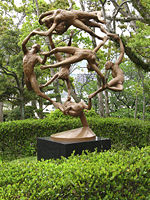
The city of Nagasaki maintains sister-city or friendship relations with other cities worldwide.[8]
Within Japan
Outside Japan
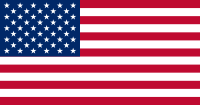 Saint Paul, Minnesota United States - (1955) Oldest sister city in Japan
Saint Paul, Minnesota United States - (1955) Oldest sister city in Japan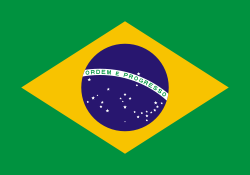 Santos, Brazil (1972)
Santos, Brazil (1972)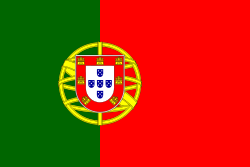 Porto, Portugal (1978)
Porto, Portugal (1978) Middelburg, Netherlands (1978)
Middelburg, Netherlands (1978) Fuzhou, People's Republic of China (1980)
Fuzhou, People's Republic of China (1980) Vaux-sur-Aure, France (2005), sister city of Sotome since 1978
Vaux-sur-Aure, France (2005), sister city of Sotome since 1978
See also
- Atomic bombings of Hiroshima and Nagasaki
- Ground Zero
- Foreign cemeteries in Japan
- Gunkanjima
- Hiroshima
- Hiroshima (film) (about the decision process behind the dropping of the nuclear bombs)
- Kokura (Kitakyushu)
- Kazuo Ishiguro, the novelist, was born in Nagasaki.
External links
- Official website
- Nuclear Files.org Comprehensive information on the history, and political and social implications of the US atomic bombings of Hiroshima and Nagasaki
- 'Nagasaki's Sister Cities
- Nagasaki JALT [Japan Association for Language Teaching] [9]
- Nuclear Weapons and Warfare
- Why Hiroshima And Nagasaki
- Nagasaki Prefectual Tourism Federation
- Nagasaki Social Networking Service
- Nagasaki Product Promotion Association
- Useful information for foreign residents, produced by Nagasaki International Association
- A Foreigner's Guide to Nagasaki
References
- ↑ Hakim, Joy (1995). A History of Us: War, Peace and all that Jazz. New York: Oxford University Press. ISBN 0-19-509514-6.
- ↑ Diego Paccheco, Monumenta Nipponica, 1970
- ↑ Cambridge Encyclopedia of Japan, Richard Bowring and Haruko Laurie
- ↑ Biological Effects of Ionizing Radiation (BEIR VII) report to the National Academies of Science, 2007
- ↑ GCatholic.com/Giga-Catholic Information: The Metropolitan Archdiocese of Nagasaki, Japan
|
|||
| Cities | |||
|---|---|---|---|
| Gotō | Hirado | Iki | Isahaya | Matsuura | Minamishimabara | Nagasaki (capital) | Ōmura | Saikai | Sasebo | Shimabara | Tsushima | Unzen | |||
| Districts | |||
| Higashisonogi | Kitamatsuura | Minamimatsuura | Nishisonogi | |||
| Subprefecture | |||
| Tsushima | |||
|
